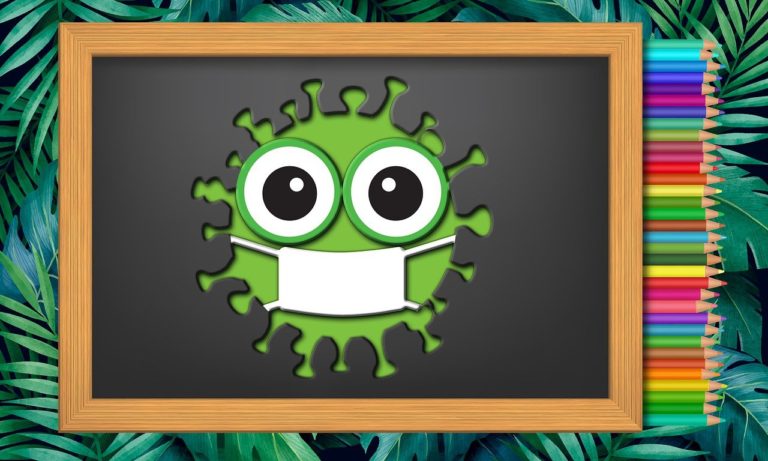
Attention! Ce contenu a été mis à jour il y a plus de 3 ans. Il pourrait contenir des liens qui ne fonctionnent plus. N'hésitez pas à nous écrire si vous en trouvez!

Main activity targets
Level(s):
Digital Competency Framework Components (QC):
Subject(s):
Adapted in English by Valérie Harnois
As part of a series of SCOOP! on COVID-19, today we answer many questions you may have on the changes you have been going through recently. With this short video, and a stack of toilet paper, we know that “we will prevail” and “we will get through this”.
The COVID-19 coronavirus causes symptoms similar to those of the flu or pneumonia in some cases. Usually, people infected will have a fever, a dry cough, and fatigue. Difficulty breathing may also be felt. Other than those most common symptoms, some cases include nasal congestion, sore throat and diarrhea. Approximately 80% of infected people will be able to heal by themselves at home. It is also possible to be a carrier of COVID-19 without having any symptoms. This is why physical distancing measures must be observed by everyone, whether they have symptoms or not.
The best and simplest way to protect yourself from the virus is to wash your hands often, with water and soap, for 20 seconds. Then, if you have to leave home, make sure to stay two metres away from other people. Also, avoid touching your face. Your hands may have been in contact with contaminated surfaces while you were at the grocery store or at the pharmacy. The best option is really to stay home and respect the confinement measures explained by the government. You can go out to get some fresh air but it is not a good idea to play or meet with friends during a pandemic. You can make video conferences to see each other but it is forbidden to meet physically. Staying home will save lives. We have to be patient and stick together.
At this point, children and teenagers are less affected by COVID-19 than the rest of the population. Compared to other people infected, they have fewer symptoms and sometimes no symptoms at all. Some hypothesis point toward the immune system of youth which would react more swiftly than adults. Others point toward the respiratory system of youth which would be less affected and contaminated by years of pollution and cigarette.
However, we should not take this pandemic lightly. You have the responsibility to avoid spreading the virus to more vulnerable people by staying at home. You could be a carrier of COVID-19 without knowing and contaminate the people around you who could develop serious complications. Your role is extremely important in this fight; we count on you.
Have you noticed, at the beginning of this sanitary crisis, that a lot of people rushed toward grocery stores. Not to buy food but to stock up on toilet paper. What do you think happened there?
According to psychologists, toilet paper is seen by some people as a symbol of security. It is thought to represent hygiene, cleanliness, and the absence of contamination. Other experts say that the action of buying basic commodities (such as toilet paper) would reduce anxiety and would give a feeling of control.
🌈 You have probably seen the rainbow drawings displayed in windows of houses in your area. This symbol of hope, during the COVID-19 crisis, started in Italy and France. A few weeks after, here in the province of Québec, a teacher in the Laurentians created a Facebook page to display children’s rainbows. The idea grew and many Québec families now have this symbol in their window, with the caption “We will prevail”, “We will get through this” or in French “Ça va bien aller”. The Jacques Cartier and Samuel de Champlain bridges also sported the rainbow colours. The Ferris wheel in Old Montreal, the Hydro-Québec logo and many other buildings and businesses show their solidarity in these unforeseen times by using the colours of the rainbow. #WeWillPrevail #WeWillGetThroughThis #CaVaBienAller
Click here to have access to a quiz created using the Quizziz platform. Click on the green button “Start“ to play.
Teachers! Click on this link to access the quiz. Then click on “Play Live“. A window will open to select the parameters you want. Then, choose a mode and invite students to play on joinmyquiz.com. You will need to give them the code provided to you on the screen. When everyone is ready, click on “Start”.
Enjoy the quiz!
Toolbox
PDF: What I Know > What I Want to Know > What I Learnt
Obtenez une suggestion de guide d'activités à découvrir chaque vendredi!
Pour vous offrir une expérience optimale, nous utilisons certaines technologies — dont les témoins (cookies) — afin de stocker et/ou d’accéder à des informations liées à votre utilisation du site. Votre consentement nous aide à mieux comprendre votre parcours de navigation et à améliorer nos contenus et services. Le refus ou le retrait de votre consentement pourrait toutefois limiter le fonctionnement de certaines fonctionnalités.